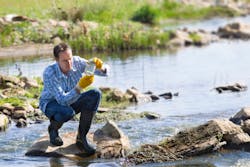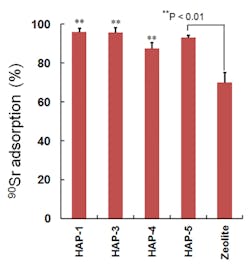Researchers discover new method to remove strontium
OKAYAMA, Japan — Dec. 21, 2015 — Okayama University researchers found a new technique effective in removing strontium 90 (90Sr) from aqueous solution, according to a press release.
The method is based on the hydroxyapatite (HAP) column procedure, noted the release, which could help remove strontium 90 from water and wastewater. "HAP is a major mineral constituent of bone and tooth and has an outstanding biocompatibility. HAP is also a possible sorbent for heavy metals in wastewater due to its high adsorption capacity and low water solubility."
Several different types of organic and inorganic adsorbents are effective in separating strontium ions, stated the release. While metal ions can be removed from wastewater, adsorption is one of the most commonly used.
Fig. 1. Adsorption efficiency of 90Sr onto HAP and zeolite examined on competing cation-free solution. *P<0.01 by unpaired Student’s t test. Courtesy of Okayama University
Tests indicated that HAP particles adsorbed more than 90 percent of 90Sr, shared the release, which was significantly more than tests using zeolite (Fig. 1). Calcium ion concentrations of up to 1 millimolar (mM) did not affect its adsorption. 90Sr was also barely affected by the magnesium levels tested.
Using a small amount of eluate, the researchers stripped 90Sr from the column and regenerated the column for another round of separation, noted the release.
90Sr has a half-life of 28.79, making it of great concern as an environmental contaminant, reported the release. Its emission of β rays "requires a complicated extraction and purification process for analysis," so few studies on the element have been undertaken. After the 2011 Fukushima Daiichi Nuclear Power Plant disaster, radioactive nuclides were emitted in large amounts.
In addition to removing 90Sr from wastewater, researchers hope the technique will also remove it from natural water in the environment, stated the release. The concentrated element could also be stored as dry, solid waste, therefore reducing disposal space and lowering costs.
You can find the entire release here.

